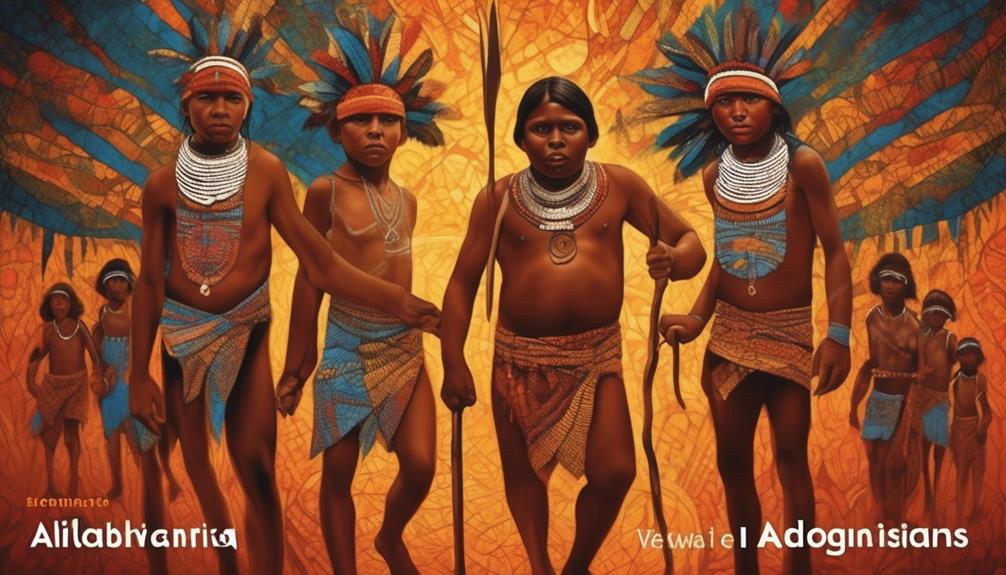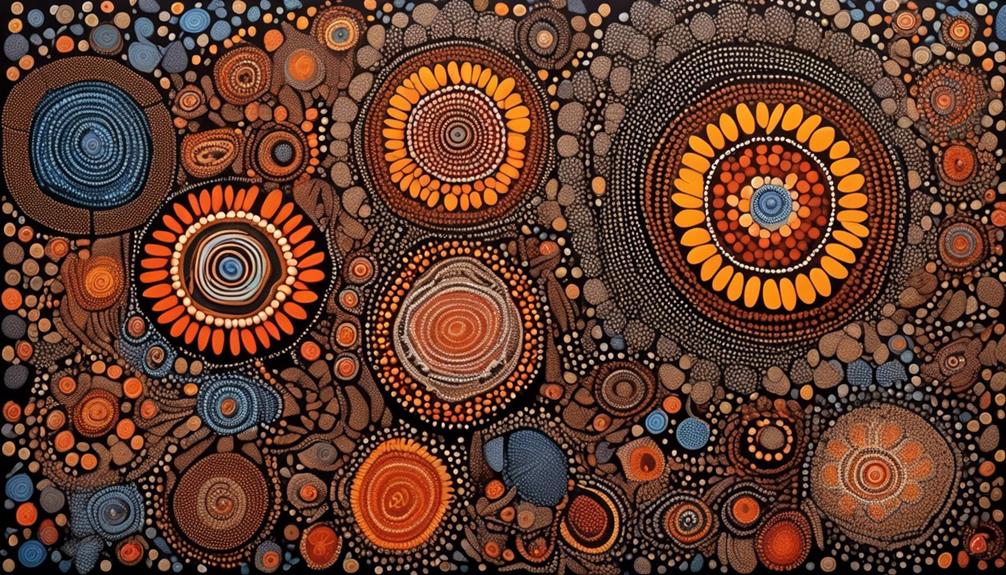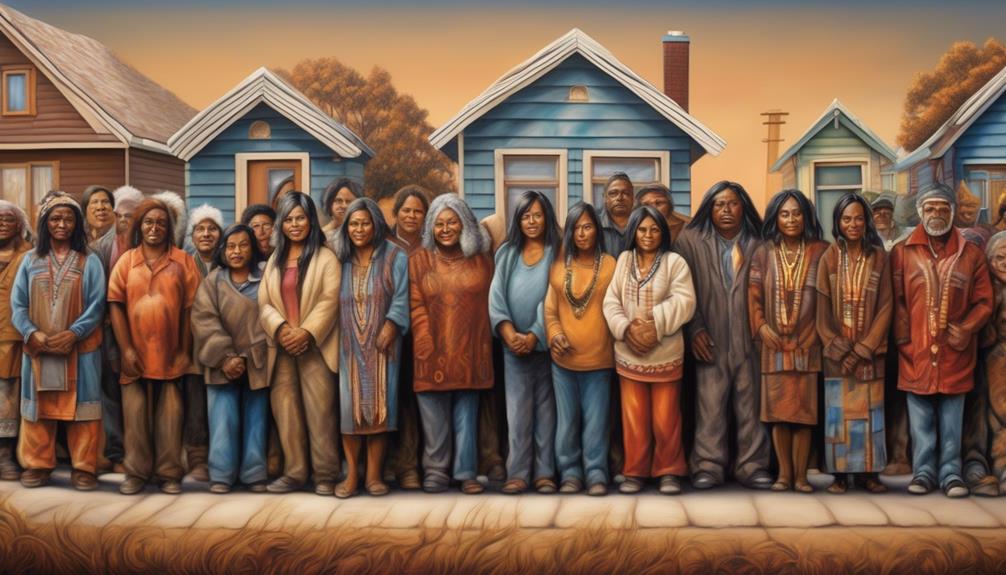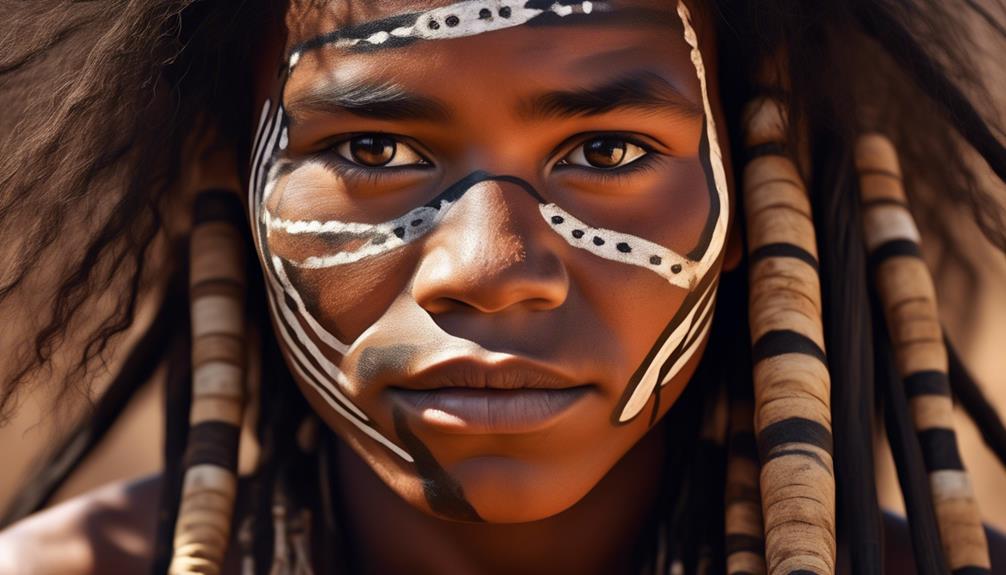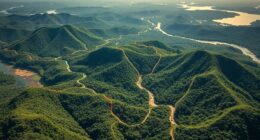Some people may not realize that Aboriginal Australians have faced a long history of mistreatment and displacement.
The treatment of Aboriginal Australians is a complex and sensitive topic that requires a closer examination of various aspects, including historical injustices, socioeconomic disparities, healthcare challenges, education and employment inequalities, and legal and justice system issues.
As we explore these issues, it becomes evident that the treatment of Aboriginal Australians is deeply intertwined with systemic and institutional factors that continue to impact their lives today.
Key Takeaways
- Aboriginal Australians have endured centuries of mistreatment and dispossession, including forced removal from ancestral lands and denial of land rights.
- Socioeconomic disparities and limited access to resources, such as job prospects, education, infrastructure, and healthcare, contribute to higher poverty rates and health disparities in Aboriginal communities.
- Mental health challenges, including stigma, limited accessibility to culturally sensitive services, and affordability issues, compound the difficulties faced by Aboriginal Australians.
- Inadequate access to quality education, systemic discrimination and prejudice in employment, and lack of culturally sensitive workplace environments create barriers to educational and employment opportunities for Aboriginal Australians.
Historical Mistreatment and Dispossession
As we delve into the history of the treatment of Aboriginal Australians, it becomes starkly apparent that they've endured centuries of systematic mistreatment and dispossession. Forced removal from their ancestral lands has been a significant part of this mistreatment. The forced displacement of Aboriginal people from their traditional lands not only resulted in the loss of connection to their cultural and spiritual heritage but also disrupted their social structures and economic stability. This has had a profound and lasting impact on their communities.
The denial of land rights further exacerbated the mistreatment of Aboriginal Australians. Land holds immense cultural and spiritual significance for them, and the dispossession of their land has been a source of deep pain and injustice. Without land rights, Aboriginal Australians have faced significant barriers in preserving their cultural practices and passing them on to future generations.
Understanding the historical mistreatment and dispossession of Aboriginal Australians is crucial for recognizing the ongoing impacts of these injustices. It's essential to approach this history with empathy and a commitment to serving others, working towards healing the wounds of the past, and advocating for justice and reconciliation.
Socioeconomic Disparities and Access to Resources

The enduring legacy of historical mistreatment and dispossession has laid the foundation for persistent socioeconomic disparities and unequal access to resources among Aboriginal Australians. It's disheartening to witness the ongoing challenges that Aboriginal communities face in accessing economic opportunities and fair resource allocation.
- Economic opportunities
Limited job prospects perpetuate financial instability within Aboriginal communities, contributing to higher poverty rates and reduced access to essential services. Educational and vocational training opportunities are often scarce, hindering the ability to break the cycle of economic disadvantage.
- Resource allocation
Basic infrastructure and essential services in many Aboriginal communities are insufficient, leading to inadequate healthcare, housing, and access to clean water. Government funding and support for economic development initiatives in Aboriginal territories often fall short, exacerbating the existing disparities.
These disparities not only impact the present generation but also have a significant effect on future prospects for Aboriginal Australians. Addressing these issues requires a multifaceted approach that involves not only policy changes but also active engagement with Aboriginal communities to understand their needs and aspirations.
It's imperative to work towards creating a more equitable society where all Aboriginal Australians have access to the resources and opportunities needed for a better future.
Healthcare and Mental Health Challenges
Experiencing firsthand the healthcare and mental health challenges within Aboriginal communities reveals the pressing need for comprehensive support and resources to address these critical issues.
Mental health stigma remains a significant barrier to seeking and receiving proper care within Aboriginal communities. The pervasive stigma surrounding mental health concerns often leads to individuals suffering in silence, without accessing the necessary support and treatment.
Additionally, healthcare accessibility in remote Aboriginal communities is a persistent challenge. Limited access to healthcare facilities, medical professionals, and essential medications exacerbates health disparities within these communities.
Observationally, it's evident that the lack of culturally sensitive mental health services further compounds the difficulties faced by Aboriginal Australians. There's a clear need for mental health services that integrate traditional healing practices and are delivered by professionals who understand and respect the cultural nuances of the community.
In addressing healthcare accessibility, it's essential to consider not only physical proximity to healthcare facilities but also the affordability of healthcare services. Financial constraints often prevent Aboriginal individuals from seeking timely medical assistance, resulting in exacerbated health conditions.
Understanding the healthcare and mental health challenges within Aboriginal communities necessitates a holistic approach that acknowledges the intersection of cultural, socioeconomic, and systemic factors. Addressing mental health stigma and improving healthcare accessibility are pivotal steps towards fostering healthier outcomes within Aboriginal communities.
Education and Employment Inequalities

Witnessing the disparities in education and employment opportunities highlights the urgent need for comprehensive strategies to address these inequalities within Aboriginal communities.
Educational barriers continue to hinder the academic success of Aboriginal Australians, perpetuating a cycle of limited opportunities. Many Aboriginal students face challenges such as inadequate access to quality educational resources, culturally insensitive curriculum, and lack of support for their unique learning needs. Additionally, the historical and ongoing trauma experienced by Aboriginal communities further compounds these educational barriers, affecting their overall well-being and potential for success.
In the realm of employment opportunities, Aboriginal Australians encounter systemic discrimination and prejudice, limiting their access to meaningful work. Many face barriers such as limited job prospects in their communities, unequal pay for equal work, and bias in the hiring process. Moreover, the lack of culturally sensitive workplace environments further exacerbates these inequalities, leading to feelings of exclusion and disempowerment.
Addressing these educational and employment disparities requires a holistic approach that acknowledges the historical injustices and actively works to dismantle the systemic barriers. It necessitates culturally relevant education, targeted support systems, and initiatives promoting inclusive workplaces to empower Aboriginal Australians and provide them with the opportunities they deserve.
Legal and Justice System Issues
Amid the complexities of the legal and justice system, it becomes evident that Aboriginal Australians continue to face significant challenges and disparities. The incarceration rates for Aboriginal Australians remain alarmingly high, reflecting systemic issues within the justice system. Discrimination, both overt and systemic, continues to plague Aboriginal individuals within legal and justice proceedings, leading to disproportionate and unjust outcomes. It is crucial to address these issues with cultural competency and respect for Aboriginal self-determination.
| Challenges | Solutions |
|---|---|
| High incarceration rates | Implement culturally sensitive rehabilitation programs |
| Discrimination in legal proceedings | Enhance cultural competency training for legal professionals |
| Lack of self-determination | Support Aboriginal community-led justice initiatives |
| Systemic issues | Advocate for policy reforms to address disparities |
The disparities in the legal and justice system are deeply concerning, and it is imperative to work towards a system that is fair and just for all. By promoting cultural competency and empowering Aboriginal communities to determine their own legal and justice pathways, we can strive towards a more equitable and inclusive system.
Frequently Asked Questions
What Are Some Traditional Aboriginal Cultural Practices That Have Been Preserved Despite Historical Mistreatment and Dispossession?
Traditional Aboriginal cultural practices, such as art and cultural ceremonies, have persisted despite historical mistreatment and dispossession. These practices are crucial for preserving the rich heritage and identity of Aboriginal communities.
Art serves as a means of storytelling and connection to the land, while cultural ceremonies maintain spiritual and social significance. Despite the challenges faced, the resilience of these traditions reflects the enduring strength and pride of Aboriginal culture.
How Do Aboriginal Communities Address Mental Health Challenges and Access Resources for Traditional Healing Methods?
We've noticed that Aboriginal communities have been actively addressing mental health challenges by incorporating traditional healing methods. It's quite ironic that despite the historical mistreatment, they've managed to preserve these cultural practices.
This approach allows for a more holistic and culturally sensitive way of dealing with mental health issues. By embracing their cultural heritage, Aboriginal communities aren't only finding healing but also reclaiming their identity and strength.
What Are Some Successful Initiatives or Programs Aimed at Addressing Education and Employment Inequalities Within Aboriginal Communities?
Education initiatives in Aboriginal communities have shown promise in addressing disparities. Programs focusing on culturally relevant curriculum and mentorship have empowered youth and improved academic outcomes.
Similarly, employment programs have provided skills training and job placement, contributing to economic stability. These initiatives recognize the value of education and meaningful work in uplifting communities.
How Do Aboriginal Communities Work Towards Restorative Justice and Healing Within the Legal and Justice System?
In working towards restorative justice, Aboriginal communities focus on community healing through cultural empowerment and legal reforms.
Restorative justice initiatives aim to address the root causes of harm and prioritize healing for both the victim and the offender. These programs often involve community members, elders, and cultural leaders, emphasizing the importance of traditional practices and values.
This approach fosters a sense of accountability and connection, promoting healing and reconciliation within the justice system.
What Are Some Examples of Successful Partnerships Between Aboriginal Communities and Government Agencies to Improve Access to Healthcare and Mental Health Services?
In our experience, community partnerships have been crucial in improving healthcare access and mental health services for Aboriginal communities. Collaborating with government agencies has allowed for tailored programs and culturally sensitive care.
For example, initiatives like community-run health centers and outreach programs have significantly enhanced access to healthcare services. Through ongoing collaboration, we've seen positive strides in addressing mental health challenges and ensuring equitable healthcare for Aboriginal Australians.
Conclusion
As we reflect on the treatment of Aboriginal Australians, it becomes clear that they've been cast into the shadows of society, like forgotten treasures waiting to be unearthed. Their journey has been marred by historical injustices and ongoing struggles, but their resilience and strength shine through like a beacon of hope.
It's time for us to listen, learn, and work towards a future where they're truly valued and uplifted.
